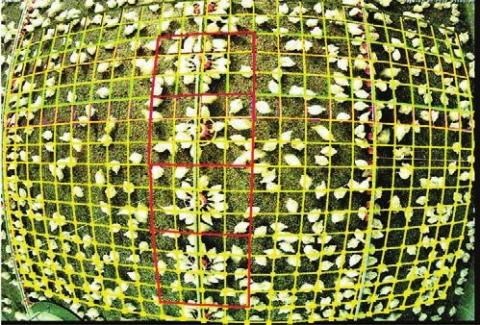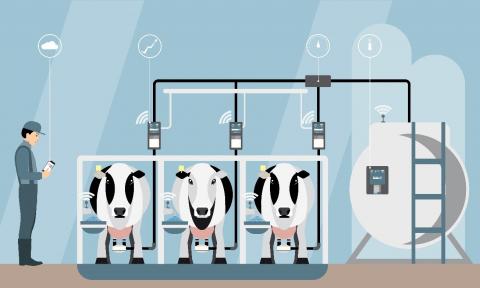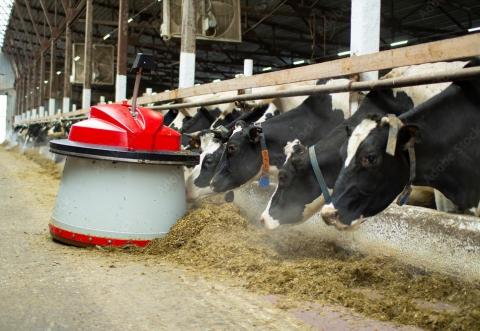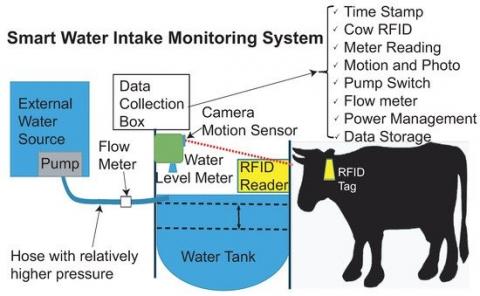16 August 2021
Dr David Cutress: IBERS, Aberystwyth University.
- Technologies can be integrated into on-farm infrastructure to improve animal welfare
- Systems that increase the ability to monitor groups of animals as individuals have the potential to massively boost welfare
- Barns, sheds and other housings offer fixed locations where sensors can be employed to monitor livestock with ease of powering and maintenance compared to on-animal sensors
Whilst general infrastructure considerations are vital for animal welfare and wellbeing (with knock-on impacts on productivity) there are also technological advancements that can improve and augment animal housing infrastructure towards increased precision control. Infrastructure such as barns, sheds and milking parlours offer great static locations in which to fit many technologies and often overcome a common problem of precision livestock technologies (PLF) which is power and battery life (as barns are likely to have mains electricity). Even if animals aren’t housed 24/7 technologies can still act as useful tools for periodic assessment of animal health and wellbeing. Generally, building infrastructure systems are also more likely to have access to Wi-Fi or direct broadband for facilitating ‘internet of things’ (IOT) connections preventing some of the common rural digital infrastructure problems. For more specific information on technologies within different areas see previous articles which focus on pigs, poultry, cattle, climate impacts and antimicrobial resistance.
Technology integration in infrastructure
Space
In fully housed systems such as poultry and pigs, a combination of sensors have been demonstrated to work well in assessing the indoor space provided for ensuring maximum welfare. In poultry, a combination of GIS systems and short-range radio sensors (essentially RFID) both on-birds and placed around the house alongside video recordings have allowed researchers to identify areas that facilitated or prevented natural behaviours and emotional states. Such systems which can assist optimisation of the use of space are also commercially available in poultry such as Eyenamic from Fancom which uses video analysis to analyse bird distribution in sheds, this is largely aimed at monitoring feeding and water intake as well as mass changes of use of space which could indicate the onset of aggressive feather pecking or other health risks.
Poultry spatial distribution camera software output
Similarly in pigs tail biting can be an aggressive behaviour associated with incorrect space use and stocking rates, amongst other things, and camera systems have been developed to alert to the onset of such behaviours. Repeated alerts of risks can indicate that environments and space may need changing and technologies can be a tool to monitor the impacts of changes to ensure optimisation. In poultry, robots have also been utilised to help encourage animals to move around the available space, improving mobility scores and reducing floor laid eggs. Interestingly some research suggests that robotic systems could lead to less stress than regular human observations improving animal welfare. Robotic milking systems (RMS) can have varying impacts but if designed correctly, for example by incorporating large waiting areas and utilising free traffic flows compared to forced traffic, these can reduce stress and give animals more freedom of choice.
Bedding
A key aspect of bedding comfort and hygiene are moisture levels; therefore, it would be assumed that the inclusion of moisture/temperature sensors close to bedding levels could perform real-time analysis for improved bedding management. However, little research appears to focus on this aspect of precision livestock control. One system assessed the ability of thermal cameras to spot cold bedding spots in cattle due to wet bedding which could in future facilitate alerts for when areas required cleaning. In poultry, tools are already commercially available through autonomous robots which turn/remove and clean floor litter towards reducing disease risk and gaseous emissions.
Thermal imaging camera showing wet areas in bedding in blue scale
Ventilation temperature
Designing buildings with temperature concerns in mind is the first step to producing a good environment for livestock, but this can be improved by taking advantage of wireless temperature sensors and systems that can link these into ventilation and heating controls to automate responses to changing conditions. When adding temperature sensors, humidity sensors and airflow sensors these should be placed at multiple levels in barns (to evaluate overall building conditions and more direct animal level conditions). Accurate analysis of airflow can help to minimise impacts of ammonia for example which as well as being a key greenhouse gas is also detrimental to animal health. Infrared thermography (IRT) or more commonly thermal cameras have been assessed to monitor animal welfare in many ways by evaluating temperature fluctuation associated with reproduction, growth and disease. One example involves observing calf body temperature which could be accurately assessed and used to alert of health issues early to avoid welfare concerns as well as production and growth losses. There is scope for these along with other on-animal sensors to be combined with ventilation/heating system controls to further refine indoor environmental conditions to ensure they are ideal for animals with minimal labour input. Motorised shade/windbreaks in cattle sheds are commercially available and such systems should also integrate well into a holistic automation system across barns. These systems working in tandem could ensure constant optimal conditions are maintained in indoor animal environments towards optimal conditions and health. In broilers, systems combining sensors, cameras and variable ventilation controls have allowed testing which demonstrates the impact of temperature and airflow on animals towards better controlling these and designing improved building layouts. Finally, controlling temperature/ventilation whilst considering environmental impacts is also possible if farms consider technologies such as solar reflective materials for cooling buildings and solar collectors, renewable energy, or low impact energy systems such as combined heat and power (CHP) and anaerobic digestion for heating buildings.
Hygiene
In dairy systems udder hygiene is a known area of concern for welfare and productivity. Poor udder and leg hygiene scores have been demonstrated to be linked with increased somatic cell counts (SCC) and higher incidences of mastitis and other udder diseases. In systems with automatic milking, there is an automation of teat cleaning which should help to reduce these issues. Whilst this has been an area of contention (see the previous article) new research suggests adding automated disinfectant spraying of cleaning brush motors and changing brushes daily in teat cleaners can reduce mastitis associated bacteria transmissions by up to 19%. When this is combined with automated milking’s ability to give per udder quarter analysis of milk production, SCC and conductivity then automatic milking systems can be a powerful welfare tool. Robotic scrapers for indoor barns in cattle have been demonstrated to play roles in reducing greenhouse gas emissions whilst having low impacts on cattle behaviour following an adjustment period. Whilst one would assume cleaner floors should link well to improved bedding condition and also reduce the incidence of diseases such as clinical mastitis and hoof disorders research evidence is currently limited to a handful of studies. However, where farmers take up robotic scraping there seems to be an on-farm positive response to their utilisation regardless of brand. Previously systems have been suggested for automated robotic cleaning of livestock building as this is an area known for high labour demand and potential risks to human health. Whilst a handful of agriculture specific robotic cleaning concepts can be found in literature this seems to currently be an under-researched application though some commercial systems appear to be available in pig production. Another tool for overall hygiene and protection of pig health can be seen in new developments of biosecurity precision options. A system produced by PigCHAMP called Biorisk looks to have sensors on farm-staff and readers across sheds to observe staff movement which could correlate with infection outbreaks in animals. This can allow swift treatment, removal of animals from risk areas and identification of hygiene risk for improved infrastructure design and reduce livestock illness. It could well be a system that’s adaptable to other indoor or partially-indoor livestock areas in future also.
In poultry, dead bird detection can be important for reducing disease spread and improving overall hygiene and both robots and camera systems linked to artificial intelligence have been developed which can differentiate dead from living birds to either alert their need for removal or to do this automatically.
Feed and water access
In the pig sector, correctly designed and implemented automatic feeders have been demonstrated to impact aggressive behaviours between animals and can improve feed intake for healthier less stressed animals. Similarly, automated feeding of calves is an area that sees more regular use on modern farms. Automated systems allow better control and analysis of animal intake daily and can be used to spot patterns that may be associated with illness, incorrect infrastructure design (for example if pens encourage bullying for access to feeders) and other behavioural factors. Monitoring feed intake has been a key pursuit within livestock research as this is a key element of optimising production. Accelerometers on animals have attempted to be used but the accuracy can be variable, individually penned animals can be provided with food in troughs complete with weighing scales but this can be challenging in intensive group-housed systems. RFID readers next to feed areas can estimate feeding time but can be confounded by animals standing in feeding areas and not eating. RFID systems could also be linked to stations that release specific feed rations for each animal’s needs and be linked with weighing to assess animal intake, common in pig production but could be considered for other livestock including sheep. Such feed systems tend to be solo feeders and if they provide a “feeding area” which allows an individual animal to feed at a time this could remove aggressive bullying behaviours in some species. AI and camera systems (standard red, green, blue [RGB] and thermal cameras) are under research in barns to either scan animals to directly observe eating or scan feed bins to calculate feed present pre and post feeding. Combining such technologies with accurate animal ID either via an RFID system or via facial recognition systems could ensure individual animals receive sufficient feed for health, welfare and production gains. Feed push robots are one way that farms can improve cattle access to feed by pushing up the feed from the feed alleys for accessibility within feeding areas. Multiple commercial systems are available and even systems that automate the collection and delivery of feed to animals as required (such as Lely and DeLaval’s automatic robot feeding systems). Automated feeding allows the increased frequency of feeds with reduced labour which has been linked to positive health impacts such as reduced subacute ruminal acidosis severity. However, to date, direct health impacts of feed automation systems are understudied compared to productivity impacts.
Many of these technologies can be implemented into the concept of precision feeding within livestock systems to have big impacts on animal welfare but it is known to be a complex system to put in place. By incorporating sensors and technologies (such as growth analysis, feed intake, environmental sensors) along with the understanding of nutrient utilisation of livestock it should be possible to better tailor diets to ensure increased productivity and reduced health impacts from nutrient deficiencies (particularly important for the health of animals and offspring during pregnancy in sheep and cattle for example).
Another key static location for technology integration can be water troughs in outdoor grazing approaches. Some analysis has been performed into using RFID readers (with and without other sensors) at these locations to monitor behaviour and water intake towards improving water trough accessibility which could easily be compatible with other grazing systems such as sheep and goats. Such systems are easily placed in indoor environments (due to easier access to power for sensors) for the same health support uses. Wireless water meters can report water usage in barns or on individual troughs (depending on where in the line they are fitted) and are commonly commercially available, however, utilising such data accurately to obtain useful information on individual animal level intakes can be difficult in group housing. One key welfare benefit of connected water flow meters is providing alerts if systems fail or are blocked to ensure animals always have water available.
Smart water intake monitoring system with multiple sensors and data collections.
Other infrastructure applications
Precision technologies can also be incorporated into modern infrastructure to improve overall animal health in a variety of ways. Incorporating RFID (or other short distance low power systems) scanners indoors can evaluate animal patterns of movement towards detecting illness, oestrus and feeding. Essential throughways can incorporate wireless digital weigh scales providing automatic up-to-date animal weights, which can be used to assess illness, detect sub-clinical issues and monitor productivity. Weight has also been demonstrated to be accurately assessed in some systems using 3D cameras (mounted above pens, in robotic milk cubicles, milking parlours etc) and is commercially utilised in pigs with research ongoing in other animals. Acoustic monitors can be applied in indoor systems due to a lack of unpredictable background noise as can occur in grazing situations. These have been evaluated and commercialised mostly in pigs and poultry though there is ongoing research into impacts in other animals. In pigs, cough detection can be a vital tool to treat and quarantine sick animals towards improved animal and herd welfare. Other potential camera vision analysis-based technologies mounted in barns could look to detect lameness, illnesses in general, body condition score, rumen fill score (cattle) and calving/farrowing. The static nature of infrastructures can allow systems like rail-mounted technologies such as Chickenboy( FAROMATICS) a ceiling-mounted robotic system for assessing poultry health. This autonomously moves around a shed using a combination of sensors as well as AI to evaluate hygiene, bird behaviour, temperature, air and light quality. Similar rail robot systems could easily be mounted within other infrastructures if deemed effective, whereas in outdoor grazing the closest equivalent would be unmanned aerial vehicle (UAV) monitoring.
Grooming is a key natural behaviour in many animals including cattle and as such the use of RFID linked smart automated cattle brush systems has been demonstrated to play roles in reducing stress but also in detecting illness as it is suggested that the frequency of visits drop in ill animals. Whilst, not infrastructure specific there is a significant push toward utilising smartphone apps for livestock welfare consideration such as i-Watchbroilers, I-WatchTurkey, AWINSheep, AWINGoat, and AWINHorse amongst others which are available on app stores. These essentially allow farmers to input information about their farm and animals to receive immediate feedback, advice and benchmarking of their welfare status and productive performance.
Summary
Several areas exist in infrastructure where technologies are being developed or have already been commercialised which can improve animal health and wellbeing (along with productivity). Whilst on animal sensors have been developed in this area these inherently come with issues such as being damaged, providing battery power and potential for removal and loss. Infrastructure integrated technologies can combat these issues by having readily available power supplies and being in locations where maintenance is more easily facilitated. Indoor Infrastructures also act as key areas of animal health concerns as it is noted that many diseases occur at higher rates indoors compared to grazing. By applying technologies in buildings, elements such as temperature (environmental and animal), airflow, disease, illness, feed intake and water intake can all be assessed. Future holistic systems where multiple sensors interact with multiple building control units could provide animals with 24/7 optimal environments improving overall animal health and welfare whilst having knock-on impacts on productivity and environmental emission reductions.
If you would like a PDF version of the article, please contact heledd.george@menterabusnes.co.uk






